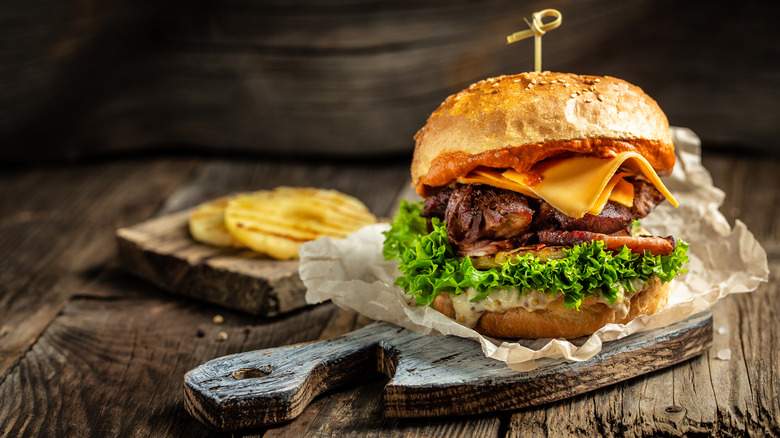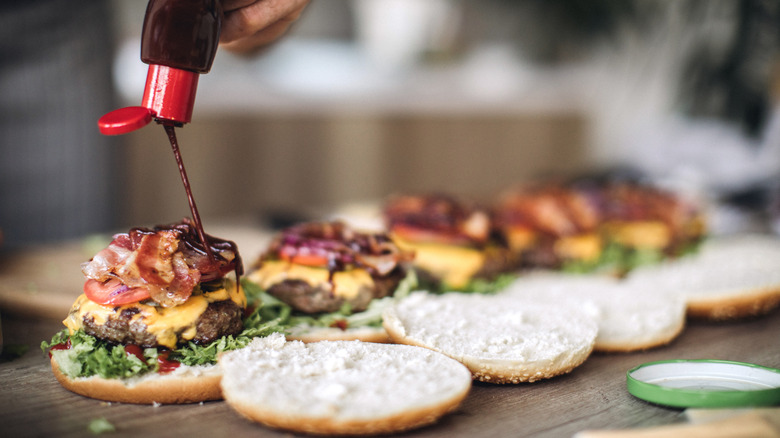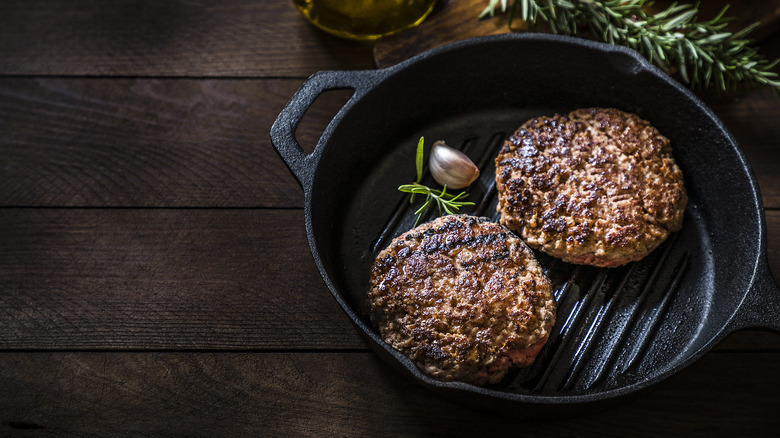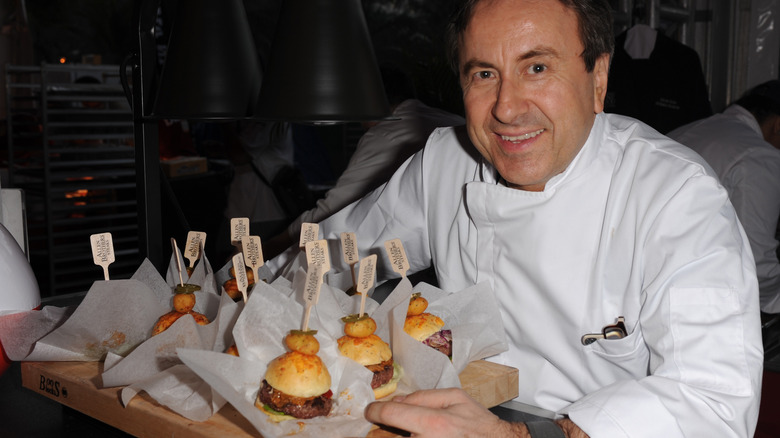What Makes A Gourmet Burger Stand Out From The Rest
Not much can top biting into a juicy, freshly cooked burger from your favorite fast food joint — except perhaps having a gourmet burger. Sure, it's a little more expensive to buy or prepare but imagine the pleasure of eating something extraordinary. There are notable differences between these two kinds of burgers, and the biggest is how the gourmet version elevates each element and step in the process of making a burger. The attention paid to how each ingredient is sourced, prepared, and cooked is meant to create a harmony of flavors and textures that transforms an American staple into a next level treat.
It all starts from the burger's main star — the patty. A gourmet patty must be made with high-quality beef and have around 25% fat. When heated, fat releases volatile compounds that give meat its recognizable flavor. This is why buying pricey cuts isn't necessary. In fact, chefs often create their own burger blends that combine various cuts and seasonings to hit the right ratio of lean meat to fat for maximum flavor.
A common recommendation is to go with the leaner grass-fed beef because it's believed to be healthier. However, studies show that both grass-fed and grain-fed beef are similar sources of essential nutrients, with the latter having more flavor-enhancing fat. Going with either is a personal preference. What's more important is knowing where the beef was sourced to determine its quality.
All the elements of a gourmet burger complement each other
To further boost the patty's flavor, a gourmet burger must also feature toppings that help elevate rather than overwhelm it. The flavor profile should be well-balanced, with all of the ingredients complementing each other. A good example of a burger that hits the right mix is our smoky chipotle burger, with a patty of ground beef mixed with chipotle chiles and topped with a chipotle mayo that utilizes the adobo sauce accompanying the chiles. It's savory and piquant, but the mayo in the sauce and the slices of avocado layered on top provide a creamy counterpoint. Another example is our fancy blue cheese-stuffed burger with fig jam and roasted pears, which features layers of sweet, salty, and umami flavors.
When it comes to the burger buns, they must be warm, mildly sweet, and pillowy, able to hold up to the patty's juices and the condiments. The usual choices are brioche, Kaiser rolls, and potato buns, although the ciabatta's crust and softer, more porous interior also make it a good choice. Freshly-made bread is ideal, but there's nothing wrong with buying from a trusted high-quality brand. Just take the extra step of buttering then grilling the buns on a skillet so they get crisped up and create a subtle crackle with each bite. Subtle details like these enhance the sensory dining experience to elevate the burger to gourmet status.
Gourmet burgers must be well-seasoned and properly cooked
Another aspect that differentiates gourmet burgers from the rest is how well-seasoned their patties are, with the spices and herbs used to support the meat's flavor rather than overwhelming it. Burger seasoning is best kept simple; the classic combo of salt and black pepper is often enough. Salt also draws out the meat's moisture when it's sprinkled on top of the patty so it becomes tastier and juicier.
If you want to layer other kinds of seasoning, consider the protein you have. Our recipe for the best lamb burger integrates onions, garlic, Dijon mustard, mint, and coriander into the patty to add depth to the meat's signature gamey taste. On the other hand, bison's sweetness needs a more delicate touch. Something light yet earthy like rosemary, thyme, and parsley works well. Chicken burgers aren't everyone's favorite because they don't feature fatty meat. However, our garlic chicken burger recipe mixes ground chicken with panade, a combination of bread and milk, which makes the patty turn out tender and moist. To find the best amount and balance of flavors, season and cook a small patty first as a test.
Proper cooking methods that create that delectable Maillard char also elevate regular burgers into gourmet ones. Oven-to-skillet reverse searing is widely recommended when cooking beef; other kinds of protein (seafood, chicken, and grains for vegetarian patties) need simpler and much quicker methods like pan-frying.
The rise of gourmet burgers has a socio-cultural aspect
When Daniel Boulud introduced the foie-gras-and-truffle-stuffed db Burger in 2001, other chefs followed suit, making bigger burgers that were overloaded with expensive, unusual toppings. According to sociologist Mark Caldwell, this kind of development is an example of cultural omnivorousness wherein chefs and foodies demonstrate their socio-economic class by displaying their wide-ranging grasp of culture, from low brow to high brow.
In the case of burgers, its ubiquity in American fast-food culture makes it "low brow" but pairing it with "high-brow" toppings and condiments makes it gourmet. Foodies then apply certain criteria to what constitutes gourmet, hence, their recommendations for "authentic" ingredients (hormone-free beef sourced from specific regions) and their enthusiasm for "exotic" toppings and seasonings. The spaces where these gourmet burgers are available are also limited, often to high-end establishments. In short, food becomes a way for the so-called high-status groups to distinguish themselves.
This approach doesn't always work, though, in terms of creating objectively delicious food. Once the novelty of having caviar, for example, in your burger wears off and the buzz of its exclusivity dies, it'll always boil down to taste. That's why you'll find arguments against the excessive nature of pricey, overloaded gourmet burgers that are more about reinforcing socio-economic class distinctions than they are about the simple pleasure of eating. Gourmet means high quality, yes, but it should also be tasty, balanced, and a delight to the senses.



